Chapter 14 Human Nutrition Textbook Exercise Questions and Answers.
1. Choose correct option
Question A.
Acinar cells are present in ……………..
a. liver
b. pancreas
c. gastric glands
d. intestinal glands
Answer:
b. pancreas
Question B.
Which type of teeth are maximum in number in human buccal cavity?
a. Incisors
b. Canines
c. Premolars
d. Molars
Answer:
d. Molars

Question C.
Select odd one out on the basis of digestive functions of tongue.
a. Taste
b. Swallowing
c. Talking
d. Mixing of saliva in food
Answer:
c. Talking
Question D.
Complete the analogy:
Ptyalin: Amylase : : Pepsin : …………….. .
a. Lipase
b. Galactose
c. Proenzyme
d. Protease
Answer:
d. Protease
2. Answer the following questions
Question A.
For the school athletic meet, Shriya was advised to consume either Glucon-D or fruit juice but no sugarcane juice. Why it must be so?
Answer:
Sugarcane juice contain disaccharides. Disaccharides take time to digest i.e. breaking into monosaccharides, Glucon — D and fruit juices contain monosaccharide. Therefore, for instant supply of energy during athletic meet Glucon – D or fruit juices are preferred and not sugarcane.
Question B.
Alcoholic people may suffer from liver disorder. Do you agree? Explain your answer.
Answer:

Question C.
Digestive action of pepsin comes to a stop when food reaches small intestine. Justify.
Answer:
Pepsin acts in acidic medium thus it is active in stomach. There is alkaline condition in the small intestine. pH of small intestine is very high for pepsin to work. Therefore, pepsin gets denatured in the small intestine.
Question D.
Small intestine is very long and coiled. Even if we jump and run, why it does not get twisted? What can happen if it gets twisted?
Answer:
3. Write down the explanation
Question A.
Digestive enzymes are secreted at appropriate time in our body. How does it happen?
Answer:
B. Explain the structure of tooth. Explain why human dentition is considered as thecodont, diphydont and heterodont.
Answer:

Question C.
Explain heterocrine nature of pancreas with the help of histological structure.
Answer:
Pancreas:
4. Write short note on
Question A.
Position and function of salivary glands.
Answer:
Salivary Glands:
Question B.
Jaundice
Answer:

Question 5.
Observe the diagram. This is histological structure of stomach. Identify and comment on significance of the layer marked by arrow.
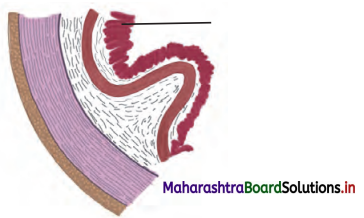
Answer:
The layer marked in the diagram represents glandular epithelium of mucosa.
Significance of the glandular epiihelium of mucosa:
Goblet cells of the epithelial layer of a mucous membrane secrete mucus which lubricates the lumen of the alimentary canal. This helps in movement of food through the gastrointestinal tract.
Question 6.
Find out pH maxima for salivary amylase, trypsin, nucleotidase and pepsin and place on the given pH scale

Answer:
Salivary amylase = 6.8
Trypsin = 8
Nucleotidase = 7.5
Pepsin = 2
Question 7.
Write the name of a protein deficiency disorder and write symptoms of it.
Answer:
Question 8.
Observe the diagram given below label the A, B, C, D, E and write the function of A, C in detail.
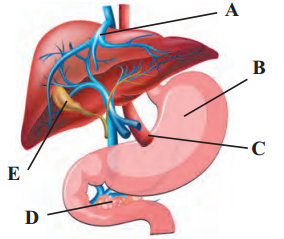
Answer:
A- Bile duct, B- Stomach, C- Common hepatic duct, D- Pancreas, E- Gall Riadder
Functions: Bile duct: It carries hile from the gall bladder and empties it into the tipper part of the small intestine. Common hepatic duct: It drains bile from the liver. It helps in transportation of waste from liver and helps in digestion by releasing bile.
[Note: Labels (A) and (O) have been modified for the better understanding of the students]

Practical / Project : Here are the events in the process of digestion. Fill in the blanks and complete the flow chart.
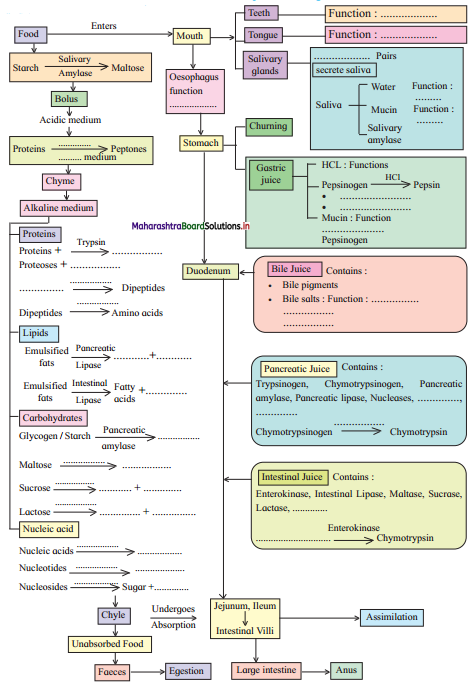
Answer:
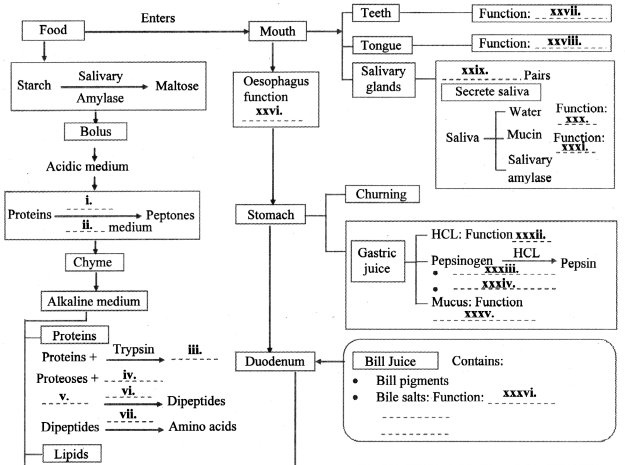
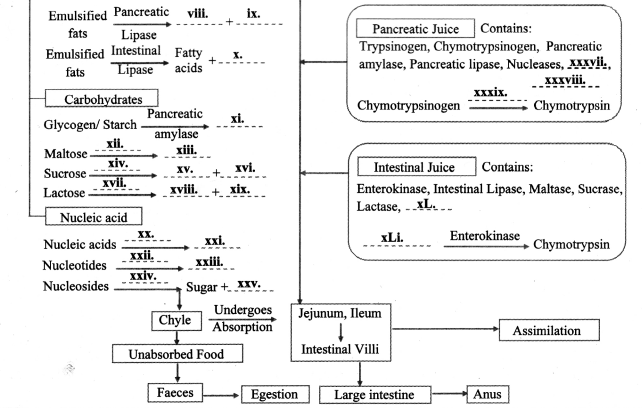
11th Biology Digest Chapter 14 Human Nutrition Intext Questions and Answers
Can you recall? (Textbook Page No. 161)
Question 1.
What is nutrition?
Answer:
Question 2.
Enlist life processes that provide us energy to perform different activities.
Answer:
The life processes which are essential and provide us energy are nutrition and respiration.
Think about it (Textbook Page No. 161)
Question 1.
Our diet includes all necessary nutrients. Still we need to digest it. Why is it so?
Answer:

Human Digestive System (Textbook Page No. 161)
Question 1.
Label the diagram
Answer:
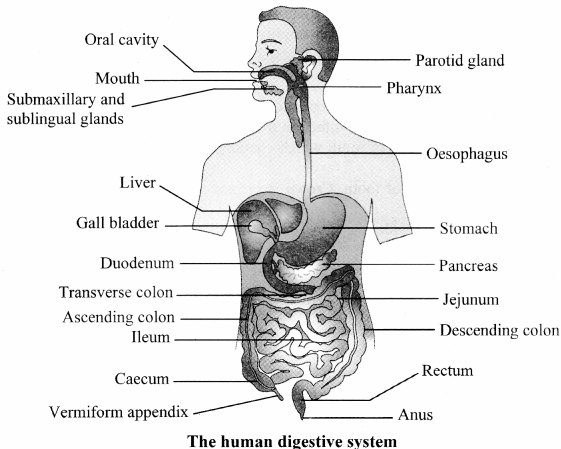
Do you know? (Textbook Page No. 162)
Question 1.
Who controls the deglutition?
Answer:
The process of swallowing is called deglutition. Medulla oblongata controls the deglutition.
Question 2.
Is deglutition voluntary or involuntary?
Answer:
Use your brain power (Textbook Page No. 165)
Question 1.
Draw a neat labelled diagram of human alimentary canal and associated glands in situ.
Answer:

Question 2.
Write a note on human dentition.
Answer:

Question 3.
Muscularis layer in stomach is thicker than that in intestine. Why is it so?
Answer:
Muscularis layer in stomach is thicker than that of intestine because food is churned and gastric juices are mixed in the stomach whereas in intestine only absorption takes place.
Question 4.
Liver is a vital organ. Justify.
Answer:
Internet my friend: (Textbook Page No. 171)
Question 1.
Collect the different videos of functioning of digestive system,
Answer:
[Note: Students can scan the adjacent Q.R code to get conceptual clarity with the aid of a relevant video.]

Find out (Textbook Page No. 162)
Question 1.
What will be the dental formula of a three years old child?
Answer:
The dental formula of a three-year-old child will be: I \(\frac{2}{2}\), C \(\frac{1}{1}\), M \(\frac{2}{2}\) = \(\frac{2,1,2}{2,1,2}\)
i. e. 5 × 2 = 10 teeth in each jaw = 20 teeth.
As a child has 20 teeth by the age of three.

Question 2.
What is dental caries and dental plaque? How can one avoid it?
Answer:
Internet my friend (Textbook Page No. 162)
Question 1.
Find out the role of orthodontist and dental technician.
Answer:
a. Orthodontics is a specialization in dental profession. Orthodontist straightens the crooked teeth, locates problem in patients’ teeth and their overall oral development. They might use X-rays, plaster molds or dental appliances like retainers and space maintainers to correct the problems,
b. Dental technicians are the ones which improves patients’ appearance, ability to chew and speech. They make dentures, crowns, bridges and dental braces.
Question 2.
What is a root canal treatment?
Answer:
Find out (Textbook Page No. 163)
Question 1.
You must have heard about appendicitis. It is inflammation of appendix. Find more information about this disorder.
Answer:

Question 2.
What is heartburn? Why do we take antacids to control it?
Answer:
Heart burn is a problem created when stomach contents (acid) are forced back up to oesophagus. It causes a burning pain in lower chest.
Antacids are bases and help to treat heartburn by neutralizing the stomach acid. The key ingredients of antacids are calcium carbonate, magnesium hydroxide, aluminium hydroxide or sodium bicarbonate.
Activity (Textbook Page No. 163)
Make a model of human digestive system in a group.
Answer:
[Students are expected to perform this activity on their own.]
Always Remember (Textbook Page No. 166)
Question 1.
Food remains for a very short time in mouth but action of salivary amylase continues for further IS to 30 minutes till gastric juice mixes with food in the stomach. Why do you think it stops after the food gets mixed with gastric juice?
Answer:
Internet my friend (Textbook Page No. 167)
Question 1.
How are bile pigments formed?
Answer:

Think about it (Textbook Page No. 167)
Question 1.
How can I keep my pancreas healthy? Can a person live without pancreas?
Answer:
Do it yourself? (Textbook Page No. 167)
Question 1.
You have studied the representation of enzymatic actions in the form of reactions.
Write the reactions of pancreatic enzymes.
Answer:
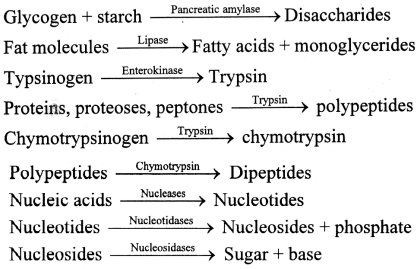
Do it yourself (Textbook Page No. 168)
Question 1.
Observe the following reactions and explain in words.

Answer:
Use your brain power (Textbook Page No. 168)
Question 1.
Make a flow chart for digestion of carbohydrate.
Answer:
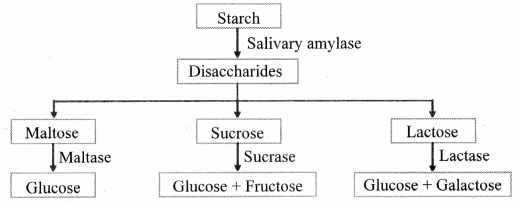

Question 2.
What is a proenzyme? Enlist various proenzymes involved in process of digestion and state their function.
Answer:
Proenzymes are synthesized in cells as an inactive precursor that undergo some modification before becoming catalytically active.
The various proenzymes involved in process of digestion are as follows:
Question 3.
Differentiate between Chyme and Chyle.
Answer:
| No. | Chyme | Chyle |
| a. | Chyme is a semi-fluid acidic mass of partially digested food. | Chyle is an alkaline slurry which contains various nutrients ready for absorption. |
| b. | Chyme leaves stomach and enters the small intestine. | Chyle leaves small intestine and enters large intestine. |
Digestion of fats take place only after the food reaches small intestine. Give reason.
Answer:
Digestion of fats takes place in small intestine because the presence of fats in small intestine stimulates the release of pancreatic lipase from pancreas and bile from liver. Pancreatic lipases hydrolyze fat molecules into fatty acids and monoglycerides and bile brings about emulsification of fats. Therefore, digestion of fats occur when food reaches small intestine.
Observe and Discuss (Textbook Page No. 169)
Question 1.
Action of digestive juice in your group.
Answer:
|
Digestive juices |
Action |
| Saliva | Saliva contains salivary amylase which breaks down starch into maltose. |
| Gastric juice | HC1 breaks converts inactive pepsinogen into its active form pepsin. Pepsin then breakdown proteins into peptones and proteoses. |
| Pancreatic juice | Pancreatic amylase acts on glycogen and starch and converts those into disaccharides. Enterokinase converts trypsinogen into trypsin (active form). Trypsin converts proteins, proteoses, peptones to polypeptides. Chymotrypsin converts polypeptides to dipeptides. Nucleases digest nucleic acids to pentose sugar. |
| Intestinal enzymes | Maltase converts maltose to glucose. Sucrase converts sucrose to glucose and fructose. Lactase converts lactose to glucose and galactose. Dipeptidases converts dipeptides to amino acids. Lipase converts emulsified fats into fatty acids and monoglycerides. |
| Bile juice | It brings about emulsification of fats. |
Digestive juices
Action
Can you recall? (Textbook Page no. 170)
Question 1.
What is balanced diet?
Answer:
Balanced diet is a diet which contains proper amount of carbohydrates, fats, vitamins, proteins and minerals to maintain a good health.
Question 2.
Explain the terms undernourished, over-nourished and malnourished in details.
Answer:
Do you know? (Textbook Page No. 170)
Question 1.
What is gross calorific value?
Answer:
The amount of heat liberated by complete combustion of lg food in a bomb calorimeter is termed as gross calorific (gross energy) value.
Question 2.
What is physiological value?
Answer:
The actual energy produced by 1 g food is its physiological value.
Question 3.
Name the following
Energy content of food in animals is expressed in terms of?
Answer:
Heat Energy
Question 4.
Complete the following table representing Gross calorific value and physiological value of food component.
|
Food Component |
Gross calorific value (Kcal/g) |
Physiological value (Kcal/g) |
| Fats | (A) | 9.0 |
| (B) | 5.65 | 4.0 |
| Carbohydrates | (C) | (D) |
Food Component
Physiological value (Kcal/g)
Answer:
|
Food Component |
Gross calorific value (Kcal/g) |
Physiological value (Kcal/g) |
| Fats | 9.45 | 9.0 |
| Proteins | 5.65 | 4.0 |
| Carbohydrates | 4.1 | 4.0 |
Food Component
Physiological value (Kcal/g)
Find out (Textbook Page No. 171)
Question 1.
Find out the status of nialnutrition among children in Maharashtra and efforts taken by the government to overcome the situation. Search for various NGOs working in this field.
Answer:
93,783 children have been diagnosed with severe acute malnutrition and 5.7 lakh with moderate acute malnutrition in Maharashtra.
Steps taken by government to overcome malnutrition:
Various NCOs working in this field:
Question 2.
Are jaundice and hepatitis same disorders?
Answer:
Jaundice and Hepatitis are two different disorders.
Jaundice: Jaundice occurs when the rate of bilirubin production exceeds the rate of its elimination. It causes yellowing of skin and eyes.
Hepatitis: It is a disease where there is inflammation of liver. It may be caused because of infection, over alcohol consumption, immune system disorder etc.
Do you know (Textbook Page No. 171)
Question 1.
Alcoholism causes different disorders of liver like steatosis (fatty liver), alcoholic hepatitis, fibrosis and cirrhosis. Collect more information on these disorders and try to increase awareness against alcoholism in society. Collect information about NGOs working against alcoholism.
Answer:
Steatosis (fatty liver): Steatosis is accumulation of fat in the liver. Treatment can help but it cannot be cured. Major risk factors are obesity and Diabetes type II, it is also associated with excessive alcohol consumption. Fatigue, weight loss and abdominal pain are some symptoms. It is a benign condition but in very smaller number of patients it can lead to liver failure. Treatment involves diet and exercise to reduce obesity.
Alcoholic hepatitis: Alcoholic Hepatitis is liver inflammation caused by excessive consumption of alcohol. It occurs in people who drink heavily for many years. Symptoms like yellowing of skin and eye, accumulation of fluid in stomach which leads to increase in stomach size. Treatments like completely stopping of alcohol consumption, hydration and nutrition care are carried out. Administration of steroid drugs reduces liver inflammation.
Fibrosis: There is significant scarring of liver tissue in this condition. Fibrosis itself does not cause any symptoms. Diagnosis includes doctor’s evaluation, blood tests and imaging tests, liver biopsy. Treatments include stopping the consumption of alcohol. There are no such effective drugs for curing of fibrosis.
Cirrhosis: It is a chronic liver damage caused due to various reasons which leads to irreversible scarring of liver and liver failure. Causes of cirrhosis are chronic alcohol abuse and hepatitis. Patients may experience fatigue, weakness and weight loss. In later stages, patients may develop jaundice, abdominal swelling and gastrointestinal bleeding. In advanced stage, a liver transplant is required.
NGOs working against alcoholism: